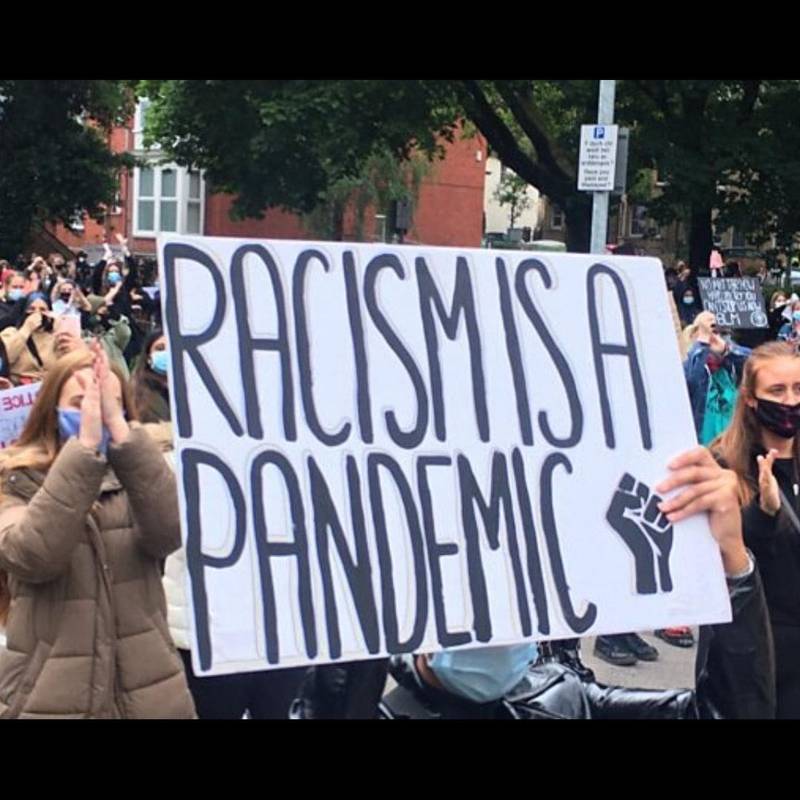Fashion isn’t just a depiction of how we present ourselves to society, but how our society places importance on our appearance through the perspective of others. Fashion can be self-expressive, thought provoking, comical and even shocking.
The global fashion market is expanding every day, but often, the global fashion runways do not reflect that reality. On average, black models make up for six percent of models used on the runway during the fashion month calendar. This small percentage is also mirrored in advertisements and editorials featured in popular fashion magazines. In the 1970s, black models were met with great opportunities, and that success trickled down into the 1980s and the 1990s. As the 90s came to a close, top designers opted for an aesthetic that ultimately excluded models of color, but black models beared the brunt of that deal. Since then, the conversation surrounding racism in fashion surfaces every season, as the numbers of black models remains stagnant. Is the fashion industry racist? Who is to blame? How can the issues be addressed so that black models can thrive as their white counterparts have? Will fashion ever exist in an era that mirrors the 1970s?
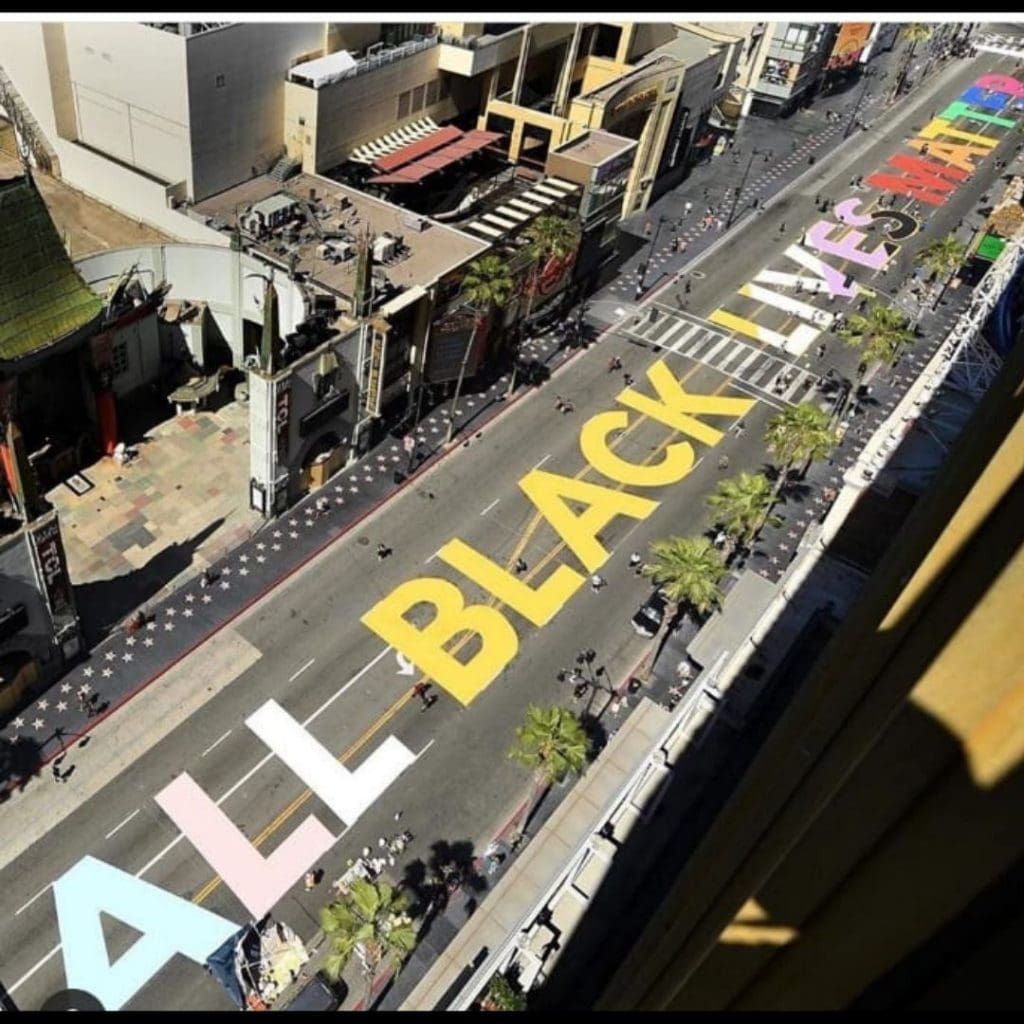
Fashion is living a painful reality. Whitewashed runway shows, campaigns and editorials have been a lasting truth in the world of fashion and, despite movements otherwise in the past decades, racism in the industry continues to be unavoidable. Now more than ever, in light of the myriad brutalities inflicted on the black community in America and beyond, the murder of George Floyd by white police officers has triggered an all-round revolution enough to make fashion wake up and consider its future.
Marches all over the world want to bring a tangible change to the system, for which protesters have emblazoned cardboard placards with phrases like ‘I Can’t Breathe’ and ‘Black Lives Matter’. The fashion community has shown, over and over again, that it is willing to fight for social justice and progressive causes. So it’s worth asking how, past the solidarity shown since Floyd’s passing, the industry will grapple with racial injustice within its own ranks.
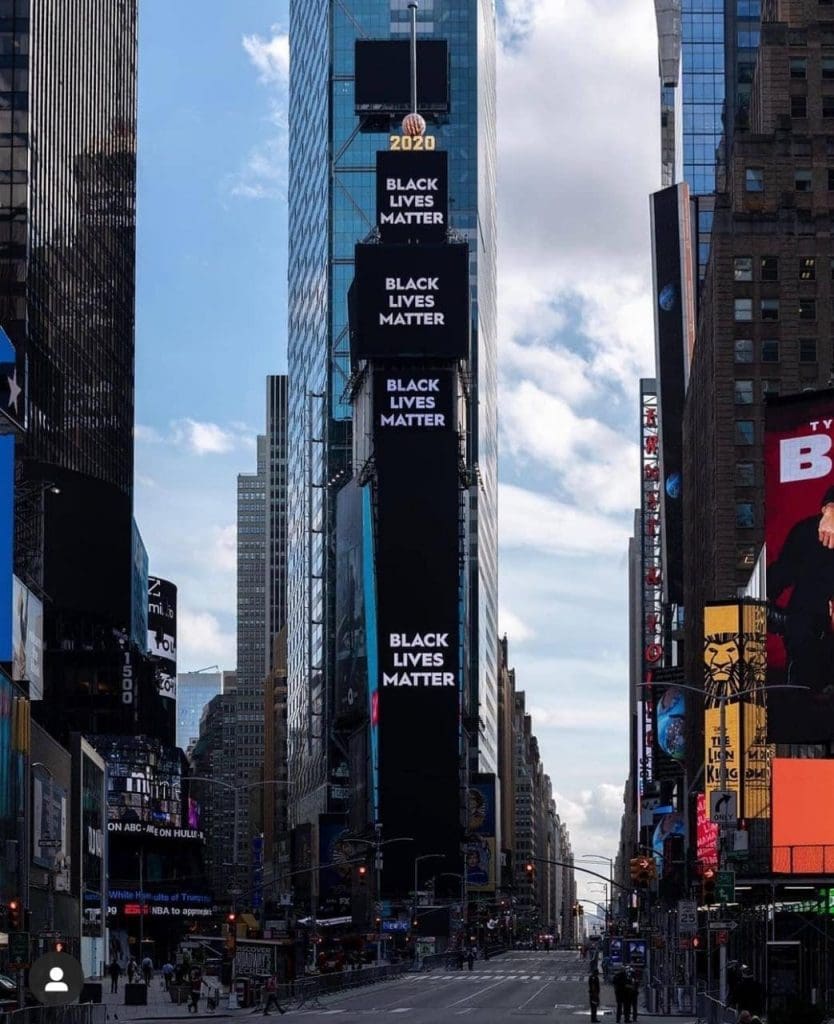
Following the death of George Floyd, yet another senseless killing of a black man at the hands of the police, anti-racism protests have swept across the United States. Chanel, Gucci and other luxury stores in wealthy neighborhoods from New York’s Soho to Rodeo Drive in Beverly Hills have been attacked, not only as targets for opportunistic looters but as symbols of inequality. According to local media reports, alongside “Black Lives Matter” and “I Can’t Breathe,” another slogan has been chanted in the streets and graffiti on buildings: “Eat the Rich.”
Now, at a time when more than 42 million Americans have lost their jobs to the Covid-19 crisis and its mishandling, with black incomes hit hardest, the resentment reflected in the protests is unmistakably about economic inequality as well as race.
To some degree, the luxury industry benefits from inequality. After all, luxury brands like Gucci and Louis Vuitton sell products most people can’t afford. But there’s more to the story. Contrary to popular belief, the “old money” rich don’t drive the luxury sector. The vast majority of luxury growth comes from “new money” consumers with rising incomes and newfound status to project.
Brands face backlash over Black Lives Matter posts.

Gucci, Louis Vuitton, Prada and Valentino have supported Black Lives Matter on social media, but some users have accused them of “virtue signalling” without a track record of positive action. Munroe Bergdorf, a black transgender model who was fired by L’Oréal in 2017 for her comments on white supremacy, accused the company of “gaslighting” after its Black Lives Matter solidarity post. Multiple media companies including Refinery29 and Paper have also come under fire.
Nike and Adidas: from “Don’t Do It” to “Together is how we make change”
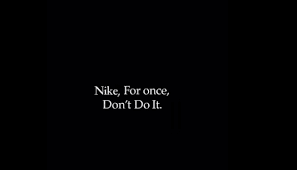
One of the first fashion firms to take a public stand against what would be a new chapter of police brutality was the American sports goods and equipment brand Nike. From there they did not hesitate to change their brand slogan “Just do it” to a “Don’t Do It” which they used as the starting point for a video release that they launched through their various social media channels. The message was shared via Twitter even by competitor, Adidas, with the message superimposed “Together is how we move forward. Together is how we make change”.
“For once, don’t do it. Don’t pretend there isn’t a problem in America. Don’t look away from racism. Don’t accept that innocent lives are taken from us. Don’t make any more excuses. Don’t think this doesn’t affect you. Don’t sit down and be quiet. Don’t think you can’t be part of the change. Let’s all be part of the change”, declared from Nike through the mentioned video.
Kering: “We will not remain silent”
Representing all its commercial brands, a portfolio including fashion houses such as Gucci, Saint Laurent, Balenciaga or Alexander McQueen, the French holding company Kering -one of the main international groups specialized in the luxury sector- has decided to publicly position itself against racism. A message of support to the community of colour, which in the case of the French company has decided to accompany various donations to organisations that fight against racial discrimination and police violence in the United States.
“Kering and all its brands are in solidarity against racism. Too many black lives have been lost in the struggle for equality in the United States” and “we will not remain silent”, they declare from Kering in a statement. “Words alone are not enough,” said the multinational, which is why “we want to contribute to organizations whose mission is focused on combating systemic racism and police brutality against the Black community in the United States. As a result of this decision, “Kering will make a donation to the NAACP (National Association for the Advancement of Colored People), an organization that fights against discrimination based on race in the United States. As well as another donation to “Campaign Zero, an organization that aims to reduce police violence in the United States. These actions will be added to those that the Group and its brands carry out on a “daily basis”, and which “we will continue to develop” through “internal initiatives and programs aimed at promoting respect, equality and equity”. “It is a journey on which we are committed to continuing to make progress by continually doing the work that is necessary”
Gucci: “We cannot allow injustice and discrimination, in any form, to prevail”
In addition to the actions carried out from its parent company, Gucci, the current flagship of the Kering group, has decided to launch its own statement of rejection of racism. The message was jointly signed by Marco Bizzarri, CEO of the company, Alessandro Michele, Creative Director, and on behalf of all Gucci employees.
“Along with the rest of the world, we mourn the loss of George Floyd and the many black men and women we have lost before him. We support those who demand justice for the violence against them,” the Italian firm said in its statement. “Our union to fight racism and to fight for equality, both as individuals and as a company, is stronger than ever. We cannot allow injustice and discrimination, in any form, to prevail”. That is why, “as drivers of change, we join the fight to end systemic racism, intolerance, police violence and oppression. “We stand in solidarity with and support the Black community, which has always supported us.
Chloé: “We will continue to speak out against injustice, inequality and racism.”
The French fashion company Chloé, also followed these recent racial protests with a statement of support for the black community. This letter was distributed through its various channels on social networks, along with a direct link to the official donation portal of the “Black Lives Matters” movement.
“Chloé positions itself as a strong ally of the black community. We will continue to denounce injustice, inequality and racism. We will continue to promote freedom and unity. In all its forms, for all people. Find your own way to make a difference,” declares the firm throughout its brief message.
H&M: “We support and will support the Black community today, every day and everywhere.”
Swedish fashion group H&M, considered the second largest textile company in the world after the Spanish Inditex, has been another of the multinationals that, in addition to its message of support, has decided to commit itself in a concrete way to the cause, announcing the donation of half a million dollars to different American organizations in defence of equality and non-discrimination.
“The recent killings of more members of the black community in the United States leave us devastated and disconsolate. Their lives, and the lives of all people of color who have been taken by violence, mattered,” said Helena Helmersson, CEO of H&M Group, in a statement. “We also recognize that we have made mistakes in the past, which have made us aware of how much we still need to learn. As a company, we are improving, but we can and must do better. So we are committed to making the past tangible to combat racism and support our employees, customers and communities. Showing symbolic support is not enough. And that is why we will take action. Most immediately, H&M’s “commitment to donate 500,000 dollars” to the NAACP (National Association for the Advancement of Colored People) Legal Defense and Education fund, the Color of Change and the ACLU (American Civil Liberties Union). “Organizations that fight for justice, economic rights and empowerment of the black community. Similarly, “we will provide our members and workers with additional resources to educate them about what is involved and implied in this whole range of prejudices. While in the United States, “we will strengthen our relationship with the Historically Black Colleges and Universities (HBCU) and increase events that seek to further empower members of the Black community,” and “we will also mobilize our efforts to increase their voter registration. “This list is not exhaustive” and “we will be meeting with working groups of Black leaders to help us with future work. But for now,” Helmersson notes, “it is important for us to be able to state firmly and unequivocally: black lives matter.
Jonathan Anderson and Loewe: “We must make more than just a statement”
From the luxury fashion sector, Jonathan Anderson and Pascale Lepoivre, respectively the Creative Director and the CEO of Loewe -one of the main firms of the LVMH group-, launched a joint communiqué in which they highlighted the attempts that the prestigious Spanish ensign will continue to make to try to strengthen even more its links with the community of colour.
“Like all of you, we at Loewe have watched the racial protests unfold in America and now the world. These protests,” add Loewe’s leaders, “have made clear what has always been an unfortunate truth,” namely that “the black community is subject to systematic racism. “Although these protests were born as a reaction to police violence,” they stress, “we must recognize and condemn racism in all its forms. We have spent the last week asking ourselves to what extent we are part of the problem and, more importantly, how we can help and become part of the solution. “Loewe exists at the intersection of fashion and art, two worlds that have always benefited from the talent and creativity of people of African descent. And that’s why, at this time, we need to make a real and sustainable commitment to the black community, which extends from our workshops to our artisans, from our philanthropic initiatives to our offices. A commitment for which the firm recognizes that “we must do more than just communicate”, and “carry out various plans of action”. These are actions that we “hope” to be able to share “with you as part of Loewe’s ongoing dedication to change”. “Meanwhile,” they added in their letter, “we hear your voices from Black Lives Matter, and we echo them
Chanel: “We are committed to fostering a culture based on trust, respect and inclusion”
As the rest of the fashion industry is doing, Chanel has decided to launch a message of support and solidarity. A message that in their case they have wanted to accompany with the black background for which they are deciding to share the majority of the users in social networks.
“Chanel denounces racism and shows its solidarity and empathy with those who feel devastated by the tragic loss of lives”. “As a company,” they add from the House of Camellias, “we are committed to fostering a culture based on trust, respect and inclusion, which are the values we uphold both among our employees and in communities around the world. At Fondation Chanel, we are committed to and support the ongoing efforts of our partners to promote and advance greater social justice. Along with our continued commitment to promoting diversity and equal opportunity within Chanel,” they add, “we are expanding our objectives to continue to promote those same values within the communities in which we live and work.
Black Models Matter: Challenging the Racism of Aesthetics and the Facade of Inclusion in the Fashion Industry
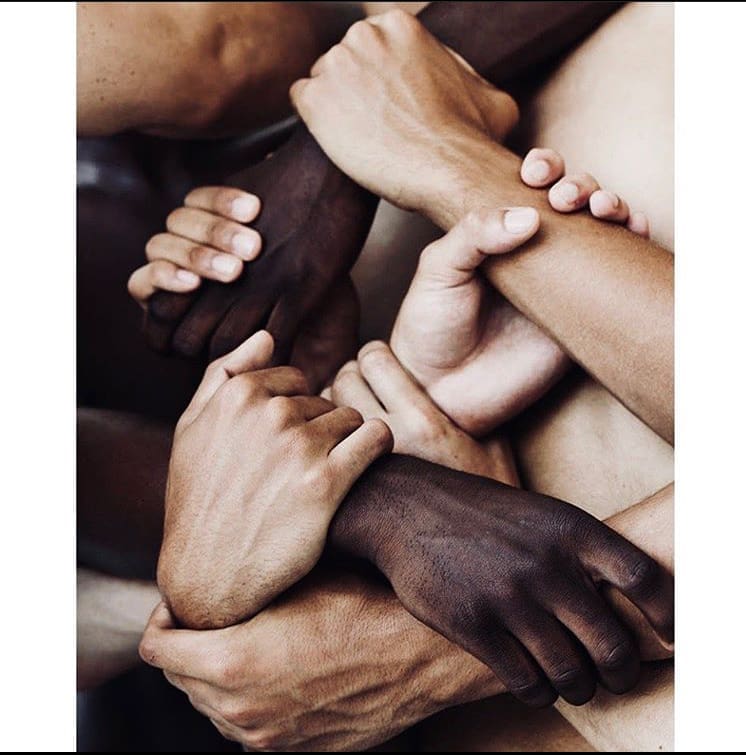
HISTORY
The 1970s saw a golden era in fashion for the black model. Black people in America, despite racial inequality, disenfranchisement, and poverty, were birthing the “Black is Beautiful” moment, which gave them visibility and elevated their sense of pride. Black culture began penetrating all types of media and influenced many art forms, notably, high fashion. As the movement took off, fashion’s decision makers saw the need to include black models on the runway and in glamourous fashion editorials and advertisements. American fashion designers tool an unprecedented chance on ten black models who stormed the runway, winning the Battle of Versailles against the already established French designers. Even through the 1990s (the era of peak Supermodels) black women saw steady careers in modelling. Models were becoming household names and experiencing a heightened level of fame. Naomi Capmbell, Veronica Webb, and Tyra Banks experienced a variety of “firsts,” and were thriving in their careers.
Black models and influencers of (editors, writers) account for a low percentage of representation in fashion. Black models account for a lower percentage of women who are featured on the runway and large-budget editorial shoots and advertisements. There is a limited demand for black models, and often, a designer can get away with casting one or two black models in their shows.
In the following Spring/Summer 2017 season, Marc Jacobs sent down a majority of white models down the runway in multi-colored faux dreadlocks, a hairstyle typically attributed to black people and black culture. This constant volleying of the concept of cultural appropriation perpetuates the idea that fashion loves black culture, but not black people.
These decisions not only affect black models, but Black influencers: editors, writers, stylists, photographers, bloggers, etc.–which come as few and far between as the models.
Problems like the ones stated above can be attributed to the absence of black influence in the fashion industry. Influencers, people who are at the top of fashion’s elite, that make the major decisions that affect the way we consume fashion aesthetically and commercially. It seems impossible for black people, black women, particularly, to penetrate these spaces. Exclusion doesn’t just manifest on the runways.
On Racism, Fashion Must Do More Than Speak Up
After yet another senseless killing of an unarmed black man at the hands of the police in the United States, the fashion industry has a duty to its customers and society at large to use its privilege and power to drive systemic change.
George Floyd’s name is now known around the globe; his death has sparked protests from Berlin to Mexico City. The extraordinary cruelty of his killing has shocked the world. But his death has resonated so widely not because it was exceptional, but because it was not. Not exceptional in the US, where the toll of African Americans who have died at police hands is long and shameful. And not, unfortunately, exceptional elsewhere.
Racism is at the heart of fast fashion – it’s time for change
Of all the shocks that the past few weeks and months have brought to all our lives, one of the biggest for me as a black woman working in the fashion industry is that finally people are realizing that racism is more than calling someone a derogatory name.
The killing of George Floyd while in police custody and the global outrage and protest that followed is bringing a dawning collective understanding that white supremacy relies on the exploitation of black and brown people.
In the fashion industry the evidence to support this awakening is rife. Racism in fashion runs to the very core of the industry, from the experience of black employees at companies such as @reformation to the lack of black models in your Instagram feeds.
Being black in the fashion industry in the UK is knowing that all the makeup artists in a room have no idea how to colour match your foundation. It is seeing a white woman monetising styles that you and your peers have been consistently ridiculed for. It is going to a press show and people assuming your business will never be able to afford to stock their clothing.
 Kalkidan Legesse outside her ethical business, Sancho’s. Photograph: Sancho’s
Kalkidan Legesse outside her ethical business, Sancho’s. Photograph: Sancho’s
Yet it is the millions of black and brown people making our clothes in factories thousands of miles away who bear the heaviest burden.
The fast fashion industry has been reliant on the exploitation of garment workers since its conception. The UK spends billions on clothes every year and yet some garment workers only take home £20 a week.
Of the 74 million textile workers worldwide, 80% are women of colour.
Brands have created a production model that keeps garment workers poor and working in unsafe conditions to maximise their own profits. The buying practices of fast fashion include turning a blind eye to illegal subcontracting and allowing forced and unpaid overtime. These practices have incentivised the erosion of garment worker rights by manufacturers and government.
The economic exploitation that fast fashion is reliant upon is a legacy of colonialism. From the 1500s until the middle of the 20th century, European imperialism was a way to create extractive states and oppress non-white people.
The legacies continue to this day. Western consumers want cheaper clothes and brands want to make larger profit margins. The knock-on injustices and exploitation in fashion’s supply chains are either accepted by consumers or obscured by conscious marketing campaigns peddling female empowerment.
And now, when the Covid-19 epidemic has presented the world with the greatest challenge we have faced in a century, we have seen the fashion industry abandon these same workers.
In many countries such as Bangladesh and Cambodia, brands are refusing to pay for billions of pounds worth of orders they had already placed with suppliers. What that means is manufacturers that purchased material destined for our high streets are now stuck with piles and piles of unwanted clothes. They are also unable to pay their workers. Hundreds of thousands of garment workers will lose their jobs because of this refusal to pay up.
For there to be meaningful change, brands need to pay garment workers living wages. It is actually that simple. This is especially true if the person who owns the brand is a billionaire.
Anger at huge shareholder payout as US chain Kohl’s cancels $150m in orders
Even though the fashion industry is making small steps in increasing outward representation and equality – 47% of models at New York’s most recent fashion week were of people of colour – there is still a long way to go.
Black people need equal representation at board level, across management levels and in the creative spaces. For a cohort to be representative it needs to make up at least 30% of the overall staff. It is not enough to put one black person in a room or on a billboard.
And while the burden of responsibility lies with the businesses making huge profits, we also have a responsibility as consumers.
If you are planning on raiding the high street for its post-lockdown sales the only message you are sending is that you are more than willing to let them continue to leave garment workers in perpetual poverty so that you can get a new slogan T-shirt stating “black lives matter” or “girl boss”.
Support black-owned businesses, sign up to their newsletters. Only buy from ethical brands that are transparent about their business practices. Sign petitions and donate to causes that are making a difference such as: Stop the Illegal Export of Riot Equipment to the US from the UK, Make White Privilege and Systemic Racism a Compulsory Part of the British Education Course and The 15% Pledge.
White allies, do it now: pull up.
PEOPLE ARE SPEAKING UP, IN FACT ALL OF US NEED TO, IF NOT NOW THEN WHEN WILL WE?
Victoria beckham
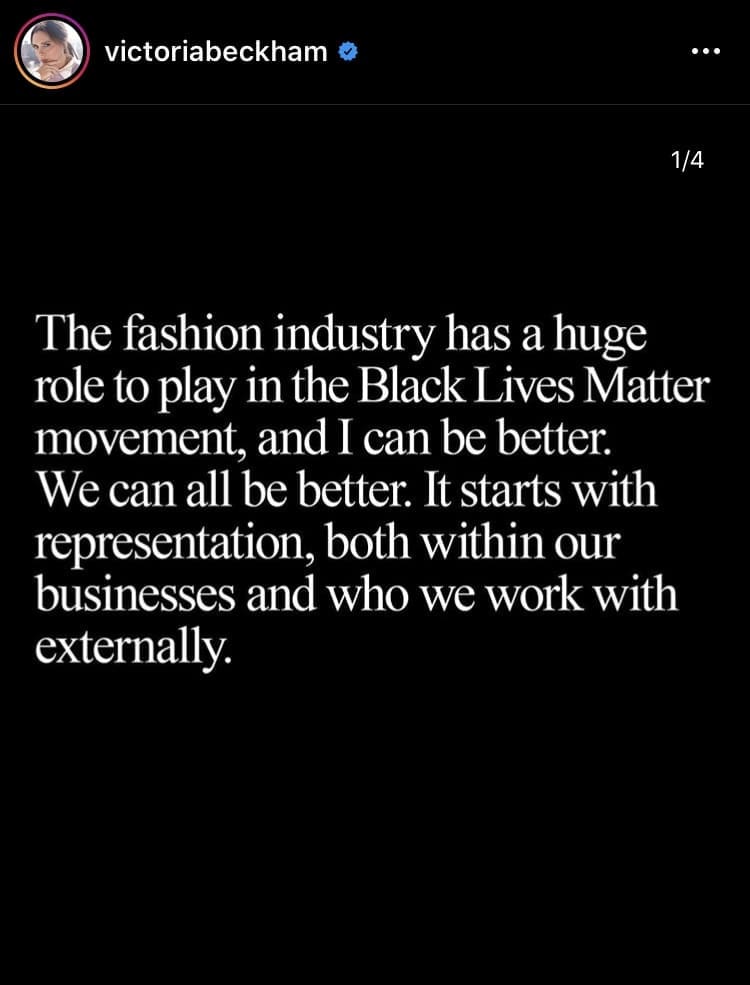
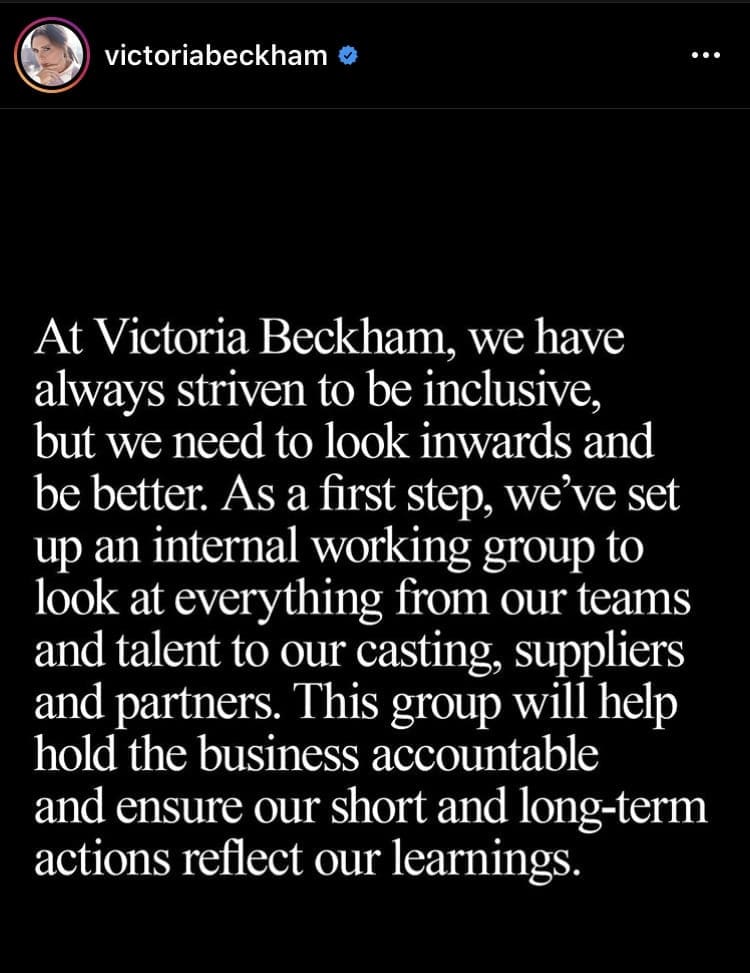
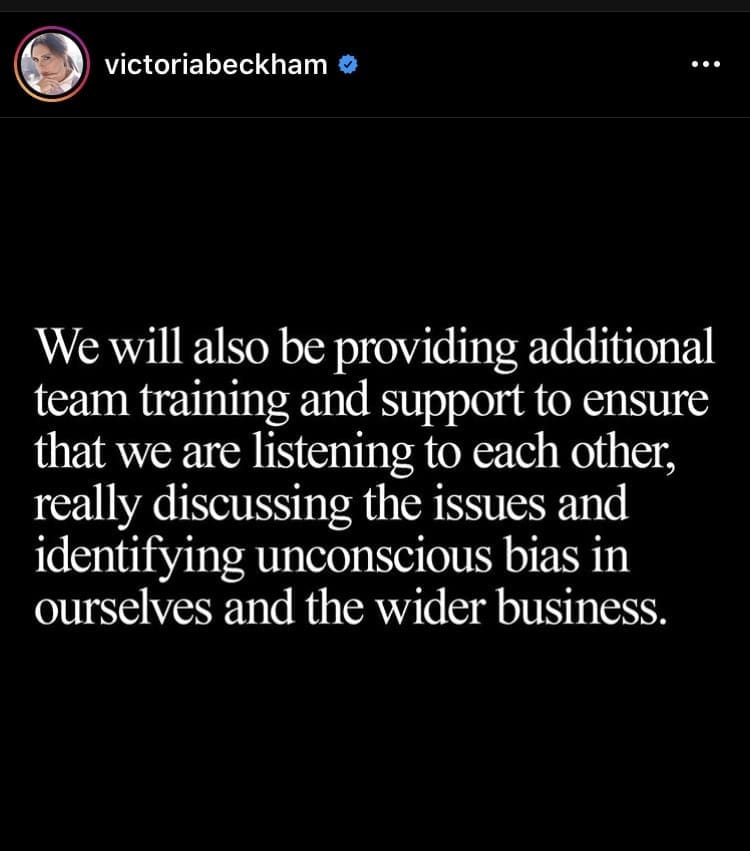
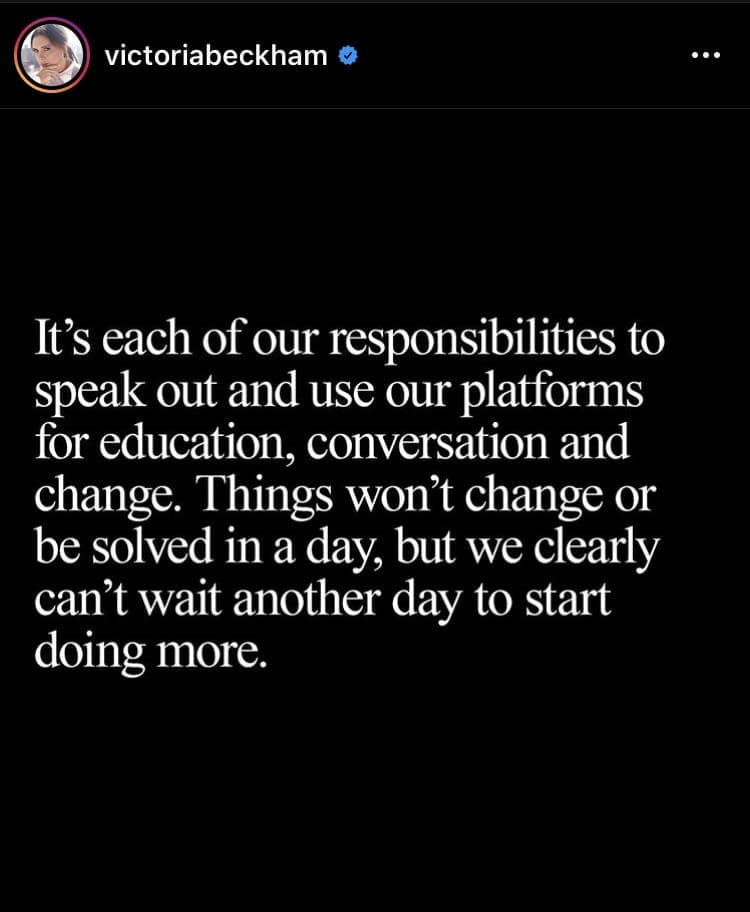
Designer Victoria Beckham believes the fashion industry has a big responsibility to promote inclusivity and show the world the way to grow above color, class and creed.
The 46-year-old fashion designer said the protest against systemic racism and police brutality, in the wake of African-American man George Floyd’s death in police custody, pushed her to set up an internal working group in her company to discuss the race issues that plague the industry. “Watching things unfold and learning more about the Black Lives Matter movement, I’ve been truly sickened by how deeply ingrained racism is in our society… “The fashion industry has a huge role to play, and for me, it starts with representation, both within my business and who we work with externally. I’ve always aimed for inclusivity, but we all need to look inwards and be better,” Victoria posted on Instagram.
Anna Wintour apologizes for race-related ‘mistakes’ at Vogue
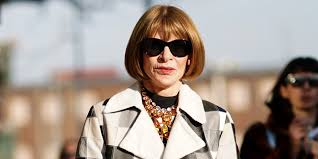
Legendary Vogue editor and fashion influencer Anna Wintour apologized for race-related mistakes of the past.
“I want to say plainly that I know Vogue has not found enough ways to elevate and give space to Black editors, writers, photographers, designers and other creators. We have made mistakes too, publishing images or stories that have been hurtful or intolerant. I take full responsibility for those mistakes.”
In addition to being editor in chief of Vogue, Wintour is artistic director and global content advisor of Condé Nast, which has come under criticism for a range of issues related to racial-insensitivity. Earlier in the week Adam Rapoport, former editor in chief Condé Nast’s Bon Appétit magazine, was forced to resign after old photos of him in brownface circulated on social media. Rappaport’s photos prompted a discussion of how the magazine, and Condé Nast as an enterprise, have historically treated its employees and freelancers that are Black, Indigenous and People of Color.

Sustainability in fashion relies on embracing diversity
Failing to overcome internal systemic racism in the fashion industry limits career opportunities for black employees and alienates customers. It also shortchanges brands’ efforts to reduce impacts on the environment.
“All of these issues are connected,” says Aja Barber, a sustainability consultant and advocate. “If the humans where you manufacture don’t have clean drinking water, then it doesn’t matter if you’re using less water in your manufacturing.”

Countries where the majority of clothing is manufactured — as well as where much of it ends up at the end of its life — are among the world’s most vulnerable to climate change, and many grapple with contaminated or insufficient water supplies and other environmental ills.As companies rush to make fixes, she warns against brands putting a person of colour in leadership or hiring a diversity and inclusion officer and thinking their work is done.
“When they’re appointed to these highly visible roles, and they’re the only one, they experience intense scrutiny, hypervisibility, very severe performance pressures and burden of doubt. Oftentimes they lack the support of the leadership team. They’re often seen as the outsider,” says Glass. It requires a deep-rooted cultural change that’s integrated into the company, she says.
Rachel Faller, founder of zero-waste brand Tonlé, says having a diverse team (she’s the only white person at the company) is pivotal to their work on sustainability. “Our core leadership team is based in Cambodia, and our team is much more directly connected to the impact of climate change and pollution,” she says. “While I’m often the one writing on social media, those views are shaped by people at Tonlé who have more first-hand experience with the issues we are trying to solve.” Faller was grateful last week to have Rae Price, Tonlé’s technical designer, guide her towards supporting black-owned businesses and promoting black educators.
“If you’ve got issues in your supply chain, if you can’t ensure your workers are treated well, then which lives matter?”
Not all brands responded that way; Price and other black fashion influencers noticed. “As black woman, it has been incredibly disappointing to see brands decide that now is a good time to have a voice in this conversation about racial injustices,” says Price. “They have been complicit in structural racism through their silence and in some cases, directly and systematically suppressing black voices and excluding black faces.”
Tapestry, which owns Coach and Kate Spade — and is one of the only major fashion groups to be led by a black man, Jide Zeitlin — has gone farther than most in the last week and committed to convening social justice, legal and corporate representatives to develop a long-term plan to combat systemic inequality. Last year, it established corporate responsibility goals for 2025, including building diversity into brand leadership teams. It aims for leadership to better reflect its full employee make-up, which was 44 per cent ethnically diverse while the leadership team stood at 21 per cent. Few other luxury brands have been so public about their goals and diversity make-up.
Black sustainable fashion advocates have named only a small number of brands who are getting it right: namely, Tonlé, Proclaim and Matter Prints. Leah Thomas, who works with businesses to integrate intersectional environmentalism and social justice into their mission statements and strategies, also names Girlfriend Collective and Outdoor Voices, two activewear brands. For others to adopt it, sustainability as a concept needs to be more inclusive, she says. pandemic began, a number of brands saying they stand with the black community have left suppliers in Bangladesh and Cambodia in millions of dollars in debt and unable to pay their workers, who are overwhelmingly women of colour. In wealthier countries, it’s communities of colour who tend to live in the most polluted areas — including the thousands of garment workers who make clothes in Los Angeles.
“If you’ve got issues in your supply chain, if you can’t ensure your workers are treated well, then which lives matter?” Barber asked, referencing the Black Lives Matter campaign.
Research has shown that companies with more diverse leadership have better environmental compliance reporting, in addition to stronger financial returns. Having people of colour on boards also makes companies more competitive and better governed, studies from Utah State University have found. The onus is on the fashion industry to change, advocates say, even sustainably focused businesses who are mostly white.
“A lack of racial diversity and gender diversity is actually hurting organisations in specific and measurable ways,” says Christy Glass, interim director at Utah State University’s Center for Intersectional Gender Studies & Research, who has conducted dozens of studies on the impacts of corporate leadership diversity on organisational functioning. “There are incredibly broad and deep benefits to having people of colour on the board and across leadership,” including better innovation and environmental reporting.
video-output-AE434FF8-2756-4BAE-89B5-159B80E1B53E (1) video-output-AE434FF8-2756-4BAE-89B5-159B80E1B53E (1)
You’re Responsibilities
Just as you have the right to expect not to be bullied because of your race or color, so it is your responsibility never to treat anyone else badly because of their race or color.
You can do this by making sure you don’t use offensive racist language, by not using racial stereotypes and by challenging people you hear making racist comments or jokes. Try to help anyone who is being treated unfairly or bullied. Let them know that they can talk to you and can count on you for support.
The article is written by – Bhavika Gulrajani & Vasavi Mehta
Reference :
https://hypebeast.com/2020/6/resonance-be-resonant-black-designer-fund-50k-usd-usa
https://academicworks.cuny.edu/cgi/viewcontent.cgi?article=3133&context=gc_etds

